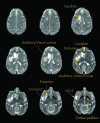Longitudinal MRI Evaluation of Ischemic Stroke in the Basal Ganglia of a Rhesus Macaque (Macaca mulatta) with Seizures
- PMID: 30486918
- PMCID: PMC6310199
- DOI: 10.30802/AALAS-CM-18-000004
Longitudinal MRI Evaluation of Ischemic Stroke in the Basal Ganglia of a Rhesus Macaque (Macaca mulatta) with Seizures
Abstract
An adult rhesus macaque developed seizures after the induction of ischemic stroke. Initially, on the day of surgery, a focal ischemic lesion was present exclusively in the right caudate nucleus. By 48 h after stroke induction, the lesion had extended into the putamen, when a seizure was observed. Our report highlights the temporal changes in infarction of unilateral basal ganglia after acute stroke and the accompanying clinical symptoms. This unusual case may provide additional information regarding the involvement of the basal ganglia in seizures, given that prior case reports and studies usually have not described the temporal and spatial evolution of the lesion before clinical symptoms emerge.
Figures




References
-
- Animal Welfare Act as Amended. 2013. 7 USC §2131–2159.

